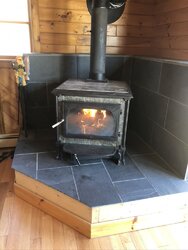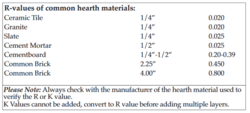Hello, I move my Mansfield form one house to another. The new home I put the stone on a raised hearth, 2X10 Frame, 5/8 plywood top, covered in 1/2" Dura Rock, Then 1/4 slate. The surround has slate Dura rock and metal framed walls this plenty of air circulation behind.
The old house had a concrete floor and it was far from wall so there was no concern about thing getting to hot. After firing up the stove I find the floor is extremely Hot, to hot to touch??? Is this a concern?? The stove corners are 8" from the slate (per the manufacturer) and the walls are hot but not as hot as the floor.
What are your thought? When is it to hot?
Thank you Brian

The old house had a concrete floor and it was far from wall so there was no concern about thing getting to hot. After firing up the stove I find the floor is extremely Hot, to hot to touch??? Is this a concern?? The stove corners are 8" from the slate (per the manufacturer) and the walls are hot but not as hot as the floor.
What are your thought? When is it to hot?
Thank you Brian



